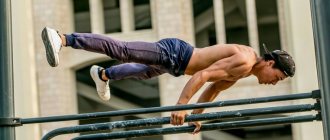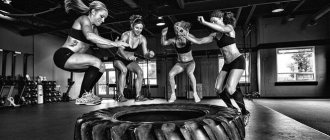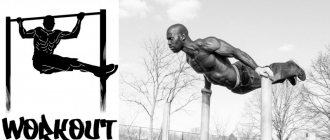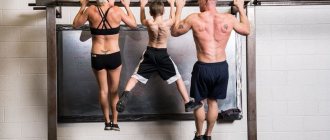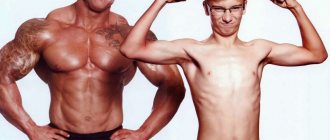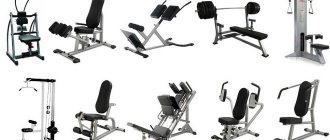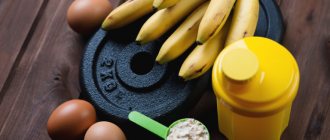© Aleksey — stock.adobe.com
Share:
Today we will talk about workout, about training that has become very popular among young people in recent years.
CrossFit is a current trend in the modern fitness industry, which has characteristics from other methods developed earlier. CrossFit has elements of bodybuilding, powerlifting, Tabata protocol, and aerobics. The key feature of this sport is the ability to combine incompatible things. In particular, CrossFit actively uses workout training.
Why did workout and gymnastics become an integral part of CrossFit? How to properly train in workout style? What benefits will this training approach bring and what is better: bodybuilding, CrossFit or street workout training? You will find detailed answers to these questions in our article.
How did it all start?
If we consider workout as a set of exercises, then it has always been included in the basic level of training for athletes of any status. You can recall the norms of physical fitness in the USSR, where the required minimums for pull-ups and push-ups on uneven bars were indicated for each age and category.
But if we consider workout as a separate discipline, then it can be called a relatively young area of fitness, which completely excludes any work with iron. Street workout arose on the basis of calisthenics - a new direction in fitness in which only rough movements are used for development:
- push ups;
- pull-ups;
- squats;
- working with the press;
- run.
Interesting fact: today street workout is a large complex of different exercises that are more related to gymnastics than to calisthenics. But the workout elements of CrossFit took all the best from calisthenics, and not from the gymnastic component of the workout.
The spread of calisthenics has become widespread with the development of the Internet. The peak of popularity of workout (in particular, street workout) is due to the fact that at the beginning of the 2000s, not all segments of the population had access to gyms, and sports grounds (especially in the CIS countries) are available in almost every yard.
Interesting fact: the original work without special equipment was at first a forced necessity, which then grew into a separate philosophy based on opposition to bodybuilding and powerlifting.
With the development of workout as a separate direction, separate subspecies began to appear. This:
- Street Workout. It incorporated not only elements of calisthenics, but also various gymnastic exercises.
- Ghetto Workout. It is also called old school Workout, or classic Workout. It retains the principles of calisthenics and implies the development of exclusively strength and speed-strength indicators without the use of special weights.
In the future, we will mainly consider ghetto workout, since it has a more extensive theoretical and practical basis and appeared earlier, therefore, it has the right to be called classic.
Principles of workout training
Basic workout training in the classical style is a whole direction. It does not include many exercises, but it allows you to acquire a basic physical shape, which in the future will be easier to polish with the help of heavy exercises with equipment.
Acting as a predecessor to CrossFit, workout is in many ways similar to it in its basic principles:
- Presence of progression. Although athletes who practice Workout do not use special weights, they otherwise use the same principles: increasing the number of repetitions, sets, decreasing rest time, supersets, strip sets and ladder approaches.
- Development of all indicators. Workout training is usually circular in nature. With a correctly composed complex, the whole body is worked out in one workout.
- Lack of special weighting shells. Weight vests that are used by athletes are just a way to reduce training time until a certain level of indicators is reached, after which further progression of loads is impossible.
- Using only basic, functional exercises.
- Lack of periodization. Since there are no extreme loads, the risk of injury is somewhat lower than for athletes working with iron. Hence the lack of overtraining effect. This is why Workout athletes can train more than once a day.
- High intensity. On average, a workout lasts from 10 to 30 minutes, during which the whole body is worked out. Longer training time is permissible only if it is necessary to develop a lagging muscle group or in preparation for competitions.
But the most important key is the desire to achieve the most sculpted shape with a predominance of lean muscle mass. The percentage of subcutaneous fat in such athletes is no higher than that of competitive bodybuilders.
Why are they needed?
Workout is a wonderful sport that is accessible and recommended to everyone without exception. Beginners perform the complex without any additional weights and spend a lot of time in the fresh air. As a result, workout allows you not only to improve body contours, increase endurance and strength indicators. Professionals who do not have enough body weight can use weights to increase their endurance.
Workout benefits everyone, and all thanks to a lot of advantages:
- These are loads that are equivalent to working out in the gym. They can easily replace cardio training.
- This is the best way to get the perfect shape without spending money on purchasing equipment.
Workout for a girl will help you get the perfect shape. - Such training has a positive effect on the condition of the spine.
- When performing difficult tricks, you can be charged with positivity from the fact that the results are high.
Advantages of this training method
If we consider different areas of fitness, the workout strength training program has its advantages over classical fitness:
- Low risk of injury. Associated with a natural range of motion and the absence of weights.
- Complex training. Unlike powerlifting and bodybuilding, Workout trains not only strength, but also endurance, as well as aerobic performance of the body.
- Availability. Workout is available to everyone regardless of their level of training.
- The ability to work your entire body in one workout.
- Low risk of overtraining.
- Helps to get a better stretch.
© evgeniykleymenov — stock.adobe.com
Disadvantages of this training method
Workout is a rather highly specialized discipline, which, although accessible to everyone, does not provide serious development in the future.
You can expect:
- Progression limit.
- Narrow specialization.
- Lack of harmonious development of the body. Due to the lack of exercises for some key muscle groups, all Workout athletes have a “characteristic” figure, with lagging rhomboid muscles and an undeveloped upper chest. In addition, the muscles of the forearms and shoulders are much more developed than the large muscles of the body. Such an imbalance is not only an aesthetic problem, but also a medical problem. In particular, due to improper development of the abdominal muscles in relation to the lower back muscles, the body is constantly in a tense state, which increases the risk of lordotic curvature of the spine.
- Inability to exercise in winter. If your body is not warmed up enough in winter, it is easy to get a sprain.
Comparison with other fitness areas
Despite the fact that workout training is considered a separate sport that in no way intersects with either classical bodybuilding or modern CrossFit, it has much in common with these disciplines.
| Periodization | Harmony of development | Development of functional indicators | Difficulty getting into sports | Injury hazard | The need to adhere to a nutrition plan, workout and daily plan | |
| Workout | Absent. The time between workouts is determined based on your own well-being. | Provides an ideal ratio of muscle mass to total mass. There is a lag in some muscle groups. | Lack of specialization. The priority is the development of explosive strength and strength endurance. | Low. Training is available to everyone. | Low. | To get better results, you need to stick to it. |
| Bodybuilding/powerlifting | Rigid periodization to achieve better results. | Harmonious development without lag. The percentage of body fat is adjusted depending on the stage of preparation. | Specialization depending on the direction. The priority is to develop strength endurance and absolute strength. | Low. Training is best done under the supervision of a trainer. | Relatively low. | |
| Crossfit | Formed by the coach or absent. It largely depends on the athlete’s well-being. | Ideal harmonious development without lag of some muscle groups. The percentage of fat is kept to a minimum. | Lack of specialization. The priority is to develop functional strength. | Low. Training is best done under the supervision of a trainer. | High. |
Workout for health. Recommendations
- Do not strive to perform complex elements from the first training sessions . Start with simple exercises on horizontal bars and parallel bars. A gradual start allows you to tone your muscles and avoid injuries when performing complex exercises.
- Reconsider your lifestyle . A healthy lifestyle and a healthy diet enhance the effect of workout training. You can start a new life right now! Workout for health together with a healthy lifestyle is a way to break out of the vicious circle of bad habits and weaknesses into which society forces a person.
- Find motivation for yourself . An unmotivated person who does not understand why he needs street sports, why he should change his lifestyle and achieve something, will not achieve success in Workout. It's not just about watching motivating photos and videos, but about understanding how a person's motivational system works. More details - follow the link above.
- Add active rest to Workout training . Sports recreation is an opportunity to experience life outside the sofa without physical and psychological stress. Understand that there is only one life, and spending it on a passive lifestyle is unacceptable.
- Study the structure of the hormonal system, reconsider your worldview . There may also be reasons for lack of motivation here. Every person strives for happiness and health. This is a norm, deviation from which should make you think about your life.
Myths about workout
There are a huge number of myths regarding workout, many of which have no basis in reality.
| Myth | Reality |
| People who do workout are much tougher than everyone else. | This myth arose from the fact that workout athletes can do more pull-ups than bodybuilders or powerlifters. In fact, the endurance and strength of these athletes are approximately at the same level. It’s just that when working with your own weight, it is not taken into account that “heavy” athletes have more weight, so for them exercises with their own weight are physically more difficult than for lighter workout athletes. |
| Workout does not require you to lead a healthy lifestyle. | This is due to the lifestyle that many representatives of workout sports lead. However, if you have bad habits, progress in calisthenics, as in other sports, slows down greatly. It’s worth taking a look at the stars of modern workout: for example, Denis Minin leads a healthy lifestyle and even enjoys working out in the gym in the winter. |
| Workout is not dangerous. | This is only partly true. This is due to the fact that the basic movements (pull-ups, push-ups and squats) have a natural trajectory of movement, which reduces the risk of injury. But for people who use muscle-ups or other gymnastic exercises, the risk of injury increases significantly. |
| Workout and protein are incompatible. | This myth was actively popularized in the CIS countries between 2008 and 2012. In fact, protein does not cause any harm and even speeds up progress in training. |
| By doing workout, you cannot gain large muscle mass. | This is only partly true. Having overcome a certain threshold, a person begins to train strength endurance and aerobic systems, which do not lead to serious myofibrillar hypertrophy. But if you use a progression of loads with weights, you will get decent muscle mass, which is not inferior to that of a bodybuilder. |
| Workout athletes are “sharper” than other athletes. | This is only partly true, since progression of loads implies acceleration of exercises, which gives an increase in explosive strength. However, in general, if a person is working on explosive strength, then the equipment and approach to training do not affect this. For example, boxers have much greater explosive power than workout athletes. |
© Syda Productions - stock.adobe.com
WHAT IS WORKOUT?
- Workout concept
- Workout without equipment. Benefits of bodyweight training
- Equipment for workout classes
- Where to train?
- Top 10 workout elements
Workout concept
Workout (eng. “Workout” - training) is a system of training with your own weight or light weights, the basis of which is the proportional development of strength, endurance and flexibility of the whole body;
a new sport that is part of the disciplines of air power athletics. The peculiarity of the training program is to perform standard sets of basic exercises. At the same time, the athlete can train both on specially equipped sports grounds and without additional equipment (on the ground).
Workout is a sports discipline that arose in a sports subcultural environment only 10 years ago, but quickly gained popularity among young people. The rapidly growing interest in workout can no longer be stopped: training has long gone beyond the confines of backyard sports grounds. Today, the “workout” direction can be seen in the schedule of fitness centers; infrastructure for classes appears in parks, shopping centers, on the territory of sports and recreational and residential complexes. Master classes, demonstration performances, competitions and festivals are regularly held, which no longer limit participants to age limits.
Workout without equipment. Benefits of bodyweight training
With the right approach, training without additional weights allows you to harmoniously develop and strengthen your entire body. Basic bodyweight exercises include familiar movements - pull-ups, squats, push-ups, planks and other functional exercises - each of which has a huge number of variations.
So, about the advantages:
- Availability. To train with your own weight, you do not need additional complex equipment. In order to perform basic exercises, you only need a little time and free space. Even if you want to diversify or complicate your exercises by including various variations of basic exercises in the program, you can adapt objects from your everyday life for training. For example, for pull-ups, it is enough to have a strong tree branch in sight and not to forget about safety precautions during training (hyperlink to the article “safety during training”).
- Practical skills. All basic exercises (along with their variations) are inherent in our body by nature, so training with your own weight is functional training, which, in addition to strengthening muscles, develops useful practical skills. For example, agility, coordination, quick reaction and the ability to control your body.
- Comprehensive muscle development. The human body is a single system, so you need to work with it comprehensively. Bodyweight exercises work all muscle groups at once, not each one individually.
- Reduces the risk of injury. Due to the fact that such physical activity is natural for the body, the risk of overloading the body and injury is reduced.
- Joint protection. Ligaments and joints are the Achilles heel of any trainer. In the modern lifestyle, they are very sensitive and vulnerable. Being unsuited for training with heavy weights, they are easily injured and take a long time to recover from injury. Typically, the weakest areas of the body are the wrists, elbows, knees, lower back, hips, rhomboids (levator scapulae), spine, shoulders and neck. Bodyweight training naturally targets your joints, strengthens your ligaments and tendons, and is gentle on your joints when used safely. Moreover, the risk of possible future damage is reduced.
- Perfect body. Strength and health are the basic principles on which bodyweight training is based. Such training will help you gain strength and flexibility and maintain these qualities for life, as well as bring the muscular system into ideal condition and give any physique a harmonious, athletic look.
Equipment for workout classes
As mentioned above, you can practice workout both without equipment and in specially equipped sports areas.
Workout sites today have all the necessary equipment that allows you not only to fully train, but also to hone combinations of elements and even prepare for competitions. Each projectile is characterized by its own shape, material of manufacture, fastening and functionality.
A professional sports ground must have:
– a classic horizontal bar on which you can train pull-ups and hangs. Essential equipment for trainees of any level of physical fitness. It is advisable if the site has horizontal bars of different heights: low, medium and high;
– Swedish wall . It is a ladder consisting of at least two vertical posts with many horizontal rungs. Exercises on the wall bars help strengthen the immune system and develop the muscles of the back, arms, abdominals and thighs. Gymnastic exercises are useful for diseases of the vestibular apparatus and musculoskeletal system. The wall bars also bring great benefits to those who suffer from diseases of the central nervous system;
- parallel bars. They look like two parallel bent crossbars about 1.5 meters high. Exercises on the uneven bars have been and remain the most effective way to pump up your biceps, triceps and pectoral muscles, in which you can adjust the degree of load simply by changing the position of your arms.
– pillars . A projectile consisting of two round steel rods, fixed in a vertical position at one end at a distance of 650 - 800 mm from each other. Perfect for practicing the Horizon element
- snake. A projectile consisting of two vertical supports connected by a zigzag steel crossbar. Often used by athletes to work the abdominal and back muscles, it is especially popular among advanced athletes.
– straight and/or inclined benches. The classic use of this projectile is pumping the rectus abdominis muscle. Using a bench, you can also diversify your usual exercises - push-ups, lunges, and various crunches.
- monkey bars A projectile consisting of several parallel steel vertical supports and transverse crossbars connecting them.
Free suspensions - loops, gymnastic rings, wicker ladders - can also be used as equipment for workout classes. The peculiarity of equipment for workout training is that it is accessible to absolutely everyone. Workout sites are open to the public for everyone.
Where to train?
Every year about a hundred new sports grounds appear in Russia. In Moscow alone there are more than 1,000 workout parks. On the interactive map of the portal you can select the workout site closest to you. If your city does not yet have professional sports facilities, you can indicate the task in the “Tasks” section.
Top 10 workout elements
All elements in workout can be divided into static and dynamic. Statics is that the athlete must fix and hold the body in a certain position, while dynamics, on the contrary, consists of the phases of the athlete’s movement relative to the projectile.
TOP 5 static elements:
- Handstand
- Horizon
- Checkbox
- Front hang
- Reverse hang (Swallow)
TOP 5 dynamic elements:
- Exit by force on 1 (2) hands
- Lift-over
- Flights via horizontal bar
- Rotations
- Steps
Many athletes combine workout elements from these two groups, obtaining interesting static-dynamic combinations. So, you can add movement to a handstand or “walk” from the starting position to a front hang.
Training program
The basic workout program has its own characteristics and consists of several main stages:
- Basic pre-training. This is the stage of preliminary preparation that every person who decides to seriously engage in workout must go through.
- Main job. A year-round stage that involves improving basic characteristics.
- Periods of specialized training. It is needed if there are lags in certain muscle groups.
- Gymnastic training. For those who want to master complex gymnastic and acrobatic movements on horizontal bars and uneven bars.
Now let's take a closer look at each stage of the program and the exercises that they include:
| Period | Periodization | Incoming exercises | Training plan | Target |
| Basic pre-training | 1-4 weeks |
|
| At the first stage, the athlete’s strength qualities are prepared and the correct technique is mastered. If the athlete’s initial training does not allow, simplified variations are used. |
| Main job | 4-30 weeks |
|
| The purpose of this stage is to maximize the development of the athlete’s strength indicators and prepare the muscles for gymnastic training. |
| Periods of specialized training | 30-52 weeks | Depending on the specialization and the lagging muscle groups, suitable complexes are selected. |
| This stage is aimed at developing lagging muscle groups. Performed in parallel with gymnastic exercises. Depending on which movements lack strength and endurance, suitable complexes are selected. |
| Gymnastics training | After the 4th week if necessary | Depending on the athlete’s level of preparedness, acrobatic variations of classic exercises are selected:
|
| Development of technique and strength in specialized gymnastic exercises. |
Recipes for healthy eating
Baked cod fillet recipe
- 6 g Protein
- 3.7 g Fat
- 0 g Carbohydrates
- 90 kcal
60 min.
- #second course
- #walnuts
- #dietary
- #baking
- #green onions
- #greenery
- #cilantro
- #gherkins
- #low calorie
- #dinner
- #vegetables
- #cucumber
- #olive oil
- #parsley
- #tomato
- #fish
- #sour cream
- #spices
- #cod
- #dinner
- #dill
- #garlic
Other recipes
Video Denis Borisov - Rocking chair or street workout (street workout)
How to increase the number of pull-ups?
In order to increase the number of pull-ups, you just need to do pull-ups! And do pull-ups as often as possible! For example, every other day.
Those. Mon, Wed, Fri you do the following:
- Pull-ups with a medium wide grip behind the head 10 sets of 3 times
- Pull-ups to the chest with a wide straight grip 10 sets of 3 times
- Pull-up to the chin with a medium straight grip 10 sets of 3 times
This is the “knurling” method, when certain neuromuscular connections are formed. Those. your brain and muscles learn to perform the exercise more efficiently. This scheme can increase the number of pull-ups to 15-20 in two months. Forward to the tanks. So that the turnstiles don’t laugh at you.
How to learn to make an exit on two
And so we need to do at least 10 pull-ups, or better yet, 15, although there are people who can do a maximum of 10 pull-ups and do 10 muscle-ups, and there are also people who do 50 pull-ups and can’t do even one. We need to learn to confidently do exits with one arm and the other (I think it won’t be too difficult if you do 15 pull-ups).
And now the most important thing is that you need to pull yourself up as high as possible (up to your chest and above) and as quickly as possible for the maximum number of times, of course you won’t be able to do this right away, you need to constantly train. You can also do push-ups on the horizontal bar, but if you do parallel bars, this is not necessary. As soon as we learn to pull ourselves up to our chest at least a couple of times, we need to throw both hands into the flags at the very last moment, at the very beginning you can jerk, help yourself with your legs, etc.
With average basic training, this will take you up to a month, but remember, it’s not realistic to learn a clean way out of two in a month (IMHO), it will be a clumsy way out. And so, when we have learned to do at least 2-3 exercises by force, we need to switch to purity, that is, do not twitch, do not help yourself with your legs, and so on until we bring it to perfection and at the same time we can train it in quantity. This will take you up to 2-3 months.
Plan for performing exercises on the horizontal bar
- Learn to do 15-20 pull-ups
- Learn to do push-ups from the bar 15-20 times
- Learn to do exits on one (each hand)
- We learn the PULL UP to the chest + both hands in the flag (we help with the body)
SUPER level – power output for two (without body help):
And so the output of strength is slow (one of the most difficult strength elements on the horizontal bar), if the previous outputs are mostly done due to speed (dynamic force), then everything is different here. The only way you can learn such an exit is to slowly lower yourself down from an emphasis, pressing your chest to the bar, and of course you can try it, you can also slowly do this on the parallel bars much easier, because the hands are in the same position and the bar doesn’t interfere, you can stick out forward.
Denis Borisov
